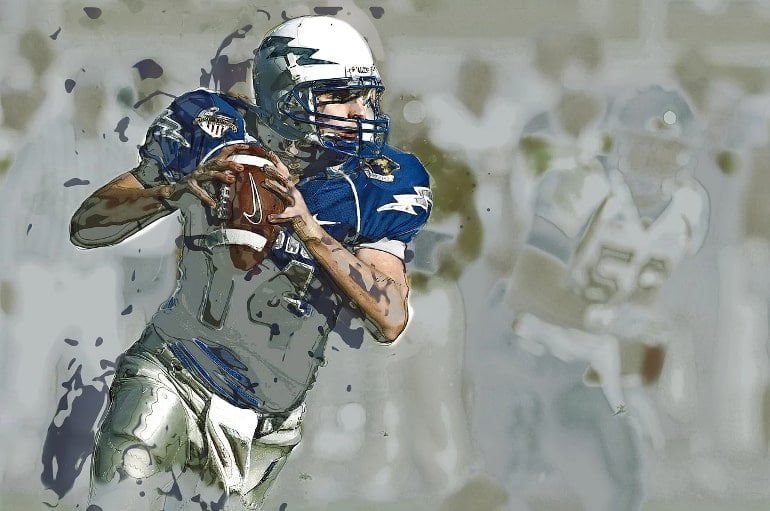Summary: The chance a former football player will be diagnosed with hypertension when they retire rises in step with the number of concussions they experienced during their career. High blood pressure may be another driver of cognitive decline in conjunction with repeated TBI for football players. However, controlling blood pressure could help slow both cardiovascular and cognitive decline.
Source: Harvard
The chance that former professional football players will be diagnosed with high blood pressure — a known risk factor for cardiovascular and cognitive dysfunction — rises in step with the number of concussions the athletes sustained during their careers, according to new research by investigators for the Football Players Health Study at Harvard University.
The results held true even after researchers took into account established risk factors known to drive the risk for high blood pressure, or hypertension, including age, body mass index, race, smoking status, and a diagnosis of diabetes.
The results of the study, published Feb. 7 in Circulation, suggest that high blood pressure may be yet another driver of cognitive decline — a condition strongly linked with professional football play in previous studies and believed to stem primarily from repeated head injury.
The findings also point to high blood pressure as a modifiable risk factor that could halt or slow both neurologic and cardiovascular damage in former players.
Given that cardiovascular illness remains a top killer in former athletes and in the general population, the researchers said the results should be an impetus for doctors, former players, and their families to consider a history of prior head injury when screening patients for hypertension — even in the absence of other risk factors for this condition.
“If players, families, and physicians are aware of the cardiovascular effects of head injury, we have a better chance of protecting both their cardiovascular health and long-term cognitive health,” said Rachel Grashow, director of epidemiological research initiatives for the Football Players Health Study. Grashow co-led the new study with Aaron Baggish, professor of medicine at the University of Lausanne, senior faculty member at the Football Players Health Study, and former director of Massachusetts General Hospital’s Cardiovascular Performance Program, which provides comprehensive cardiac care to athletes.
The research — based on a survey of more than 4,000 former National Football League players representing the largest study cohort of former professional football players to date — was conducted as part of the ongoing Football Players Health Study at Harvard University, a research program that encompasses a constellation of studies designed to evaluate various aspects of players’ health across their life span.
Grashow explained that most research on cognitive decline in former professional football players has focused on neurodegeneration caused directly by repeated concussions, a prominent aspect of the game.
However, the leading cause of death and disability among former football players — and among Americans in general — is cardiovascular disease, a collection of conditions that affect the heart and blood vessels. Hypertension, the most common cause of these conditions, can also gradually damage blood vessels in the brain and, over time, lead to cognitive decline.
Various aspects of professional football, such as purposeful weight gain during play years and deconditioning after career end, are associated with hypertension. However, Grashow, Baggish, and their colleagues wondered whether concussion might also be independently associated with hypertension.
To answer this question, the researchers collected information from 4,168 former NFL players. The team analyzed known risk factors for hypertension in the general population — diabetes, obesity, age, smoking — as well as players’ number of seasons of play, field position, years since play, and the occurrence of 10 common concussion symptoms. These symptoms were used to calculate a concussion symptom score, or CSS.
The analysis showed that as players’ symptom scores rose, so did their likelihood of being diagnosed with hypertension, even after researchers accounted for known hypertension risk factors. Notably, even using the number of occurrences of just one severe symptom of concussion — loss of consciousness — was enough to accurately predict players’ likelihood of developing hypertension.
Grashow said that while it remains unclear exactly how concussion leads to hypertension, one hypothesis is that repeat concussions could cause a chronic inflammation that prompts blood pressure to rise. Uncovering the precise mechanism underlying concussion-related hypertension will be the subject for future research, she added.

Baggish added that unlike many risk factors for cognitive decline, hypertension is potentially controllable with an array of safe and effective therapies, including routine aerobic exercise, dietary modification, and, in some cases, medication.
“By identifying those at increased risk for hypertension based on their history of head injuries, we could intervene with therapies that not only protect their hearts and blood vessels, but also their brains,” Baggish said.
Authorship, funding, disclosures
Additional authors included Can Ozan Tan, Saef Izzy, Herman Taylor Jr., Marc Weisskopf, Meagan Wasfy, Alicia Whittington, Frank Speizer, and Ross Zafonte.
Funding: This work was supported by the Football Players Health Study at Harvard University, which is funded by the National Football League Players Association (NFLPA).
The content is solely the responsibility of the authors and does not necessarily represent the official views of Harvard Medical School, Harvard University, and its affiliated academichealthcare centers.
The NFLPA had no role in the design and conduct of the study; collection, management, analysis, and interpretation of the data; preparation, review, or approval of the manuscript; and the decision to submit the manuscript for publication.
Zafonte reported receiving royalties from Springer/Demos publishing for serving as co-editor of Brain Injury Medicine; serving on the scientific advisory board of Myomo Inc., and onecare.ai Inc; evaluating patients in the Massachusetts General Hospital Brain and Body–TRUST Program, which is funded by the NFL Players Association; and receiving grants from the NIH.
Baggish has received funding from the National Institutes of Health National Heart, Lung, and Blood Institute, the National Football Players Association, and the American Heart Association and receives compensation for his role as team cardiologist from the US Olympic Committee/US Olympic Training Centers, US Soccer, US Rowing, the New England Patriots, the Boston Bruins, the New England Revolution, and Harvard University.
Taylor reported receiving grants from the NFL Players Association outside the submitted work and grants from the NIH. Weisskopf reported receiving grants from the NFL Players Association and the NIH during the conduct of the study. Grashow, Whittington, and Wasfy received grant funding from the NFL Players Association.
About this football, concussion, and hypertension research news
Author: Ekaterina Pesheva
Source: Harvard
Contact: Ekaterina Pesheva – Harvard
Image: The image is in the public domain
Original Research: Open access.
“Association Between Concussion Burden During Professional American-style Football and Post-career Hypertension” by Rachel Grashow et al. Circulation







